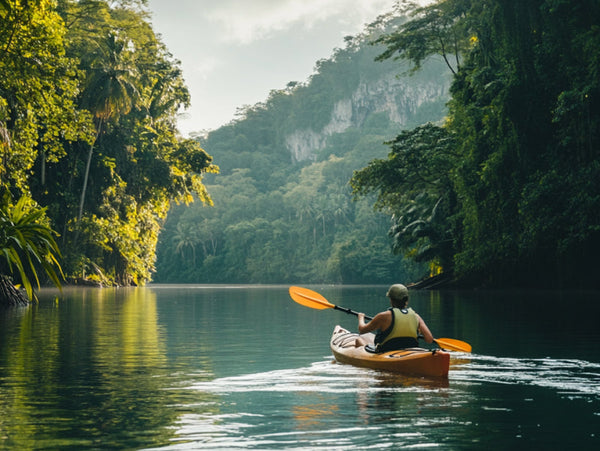Take a Walk on the Wild(life) Side...Birding in Your Kayak

It’s a late afternoon in summer. The air is warm and still.
You’re sitting in your kayak, quietly drifting along a slow, lazy river, breathing deeply, enjoying the moment.
Your young daughter and son are happily paddling on either side of your boat.
Life is filled with blessings and you’re grateful.
Suddenly, without warning, a burst of feathers explodes out of the reeds just a few dozen yards away! What the….??!!
Startled, you spin your head toward the action, just in time to see a strange looking bird with a very long neck pumping its huge, square wings as it peels off into the distance.
Its spindly legs hang down, dark ribbons trailing above the cattails.
It croaks once. Then it’s gone.
The quiet returns.
But something in you has changed. You don’t realize it then, but that shaggy silhouette, stilt-like legs and black crest are unmistakable.
You’ve just seen your first great blue heron. Neither you nor your kids will ever forget it and you’ll always be eager to see more.
Many paddlers crave exactly this experience on the water.
It’s one thing to stumble upon a mystical encounter with wildlife by accident, though.
And quite another to seek – and find – it while kayaking.

These tips may help make it happen for you – especially if you’re looking for birds:
✔️ Do some homework before you head out. By knowing a thing or two about the bird’s habits during certain times of the year and day, you’ll dramatically improve your chances of getting a glimpse. Do they usually forage for food in leafy shoreline brush? Or, like bald eagles, are they often seen perched high atop a tall tree on the edge of an island, searching for fish in the waters far below? Do they tend to cluster in small flocks, paddling around inlets, as mallards and black ducks do? Do they leave or arrive at a particular area at specific times of year? You get the idea. Knowledge will save you time.
✔️ Pick up a good field guide or download a reliable app on your phone. Many birds and other animals are so well camouflaged you might miss them entirely unless you know what to look and listen for. Field guides are a wealth of information. Most of these resources will aid you in quickly recognizing key defining features of the birds and other animals you’re looking for. Body shapes, wingspreads, vocalizations and more are all important to note when a cool bird flutters by. With a few of these nuggets committed to memory, you’ll have fun being able to identify many species on sight.
✔️ Be aware of the nesting habits of the birds you’ll be paddling near. Remain at a far distance from any bird that is actively tending eggs or young chicks. Every movement a bird makes burns precious calories it needs for survival. You don’t want to be the one who startles it and triggers it to bolt. The bird will be stressed and eggs and chicks may be damaged.
✔️ A decent pair of binoculars can be great to have, but certainly not necessary, especially when you’re starting out as a paddling bird watcher. In fact, you’ll see far more wildlife while kayaking than you ever imagined existed if you simply keep your eyes and mind open and nothing more.
✔️ Consider keeping a journal. After each outing, record what you observed while paddling. You might even sketch a few scenes from memory to boost your recall of them later. It’s also fun to review your adventures with the kids. Details in your journal can bring all the memories back to life for everyone.
No matter how you approach this new hobby, the key is to enjoy the peaceful feeling you’ll have being deeply connected with Nature.
Without question, that’s what being in a kayak is all about – every time.
Spread The Word & Pin It 😊
1 Response
Leave a comment
Comments will be approved before showing up.
Also in Blog

How to Choose the Right Kayak Anchor
Choosing the right kayak anchor can make all the difference when it comes to staying steady on the water. This guide walks you through everything you need to know about selecting the perfect folding kayak anchor

What To Do When Your Kayak Capsizes
Although kayaks are designed for stability no matter the conditions, accidents happen and knowing what to do can help you avoid an unpleasant experience. Preparedness and technique are key components to controlling a sometimes scary situation.



Robert Mason
March 17, 2021
Another way to see birds and wildlife up close is to let the wind drift you along the shoreline